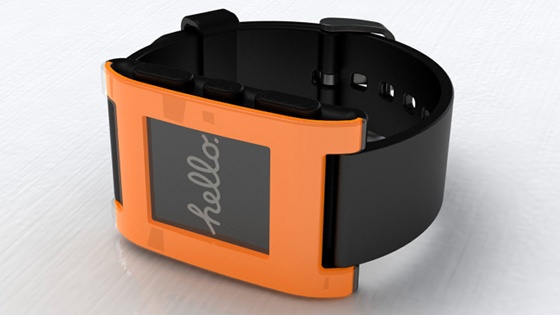
What’s interesting about the Pebble E-Paper Watch is that is isn’t the first computer we’ve worn on our wrists. In fact, the venerable calculator watch, which was still the rage (in the A/V department) when I went to high school, was the first indication that humans feel comfortable interacting with their forearms (don’t go there).
To be sure, there were signs before that, too. The chronograph is a great example of the simple and effective evolution of the wristwatch. As a child, I would take my father’s Seiko and start the timer, reset it, start it again. Its rhythm was hypnotic; its influence profound.
Today, whenever I meet a watch lover, he or she usually falls into one of two categories. The first is the obstinate refuser, the individual who will never give up his timepiece — it was his father’s, his grandfather’s; it has sentimental value. The second is the enthusiast. This person loves watches because they are beautiful; they also buck the trend that many of us have followed, often without realizing it. Good watches — those that keep accurate time and are lovingly made by hand by someone who, in my dreams, looks like my grandfather with a slightly curlier moustache — are expensive, and require regular maintenance, care and attention. Most people don’t want to deal with that. Most people, including me, have moved on.
The smartphone is the best watch ever made. It keeps accurate time, far more so than any $10 knockoff Timex; it is a timer, an alarm (with music!), a world clock. It is always with us, even when we forget to strap on our Swatch in the morning, and — barring any battery failures — it is usually reliable.
But 2013 may be the year the watch makes a comeback. Just as the smartphone replaced the feature phone, the eReader replaced the book, the MP3 player replaced the CD, the ____ replaced the ____, so too does it look like the smart watch will soon replace the watch.
Back in April, a group of engineers who originated in Waterloo, Ontario, put the Pebble E-Paper Smart Watch on Kickstarter. Though an unlikely proposition at the time — a Bluetooth-enabled watch thin enough to be mistaken for a Skagen, light enough to be forgotten, and with a screen that kill the battery in six hours. It blasted through its $100,000 target in a few hours; it ended up with $10 million and nearly 70,000 backers.
Since then, the team has worked furiously to take a prototype and scale its manufacturing to company-sized proportions. And, though there have been numerous delays the Pebble’s release is assured, and it is imminent. The team designed and re-designed the internals, added to the Android and iOS SDKs and, most propitiously of all, ensured a viable platform for years to come.
Recently, it has been rumoured that Apple is working with Intel to bring a smart watch to the market some time in 2013. Though the rumour is unsubstantiated — as are all Apple products until they’re announced — it bears taking seriously for a couple of reasons. Apple recently redesigned its iPod nano, disavowing future generations of “nano watches.” It would be myopic of Apple to give up that huge potential market share; slim it down, add Bluetooth and explicit iOS API support, and you’ve got a viable and potentially profitable companion to an iPhone or iPad.
There have been some attempts at smart watches over the past couple of years, most notably the Sony SmartWatch, which had tons of potential but ended up tripping over its own Android-limited feet. Too clunky, with poor battery life and a litany of bugs, the SmartWatch never quite offered the experience users wanted.
At last year’s CES, an Italian company of the same name showed off the i’m watch, another Android-based timepiece. It too offered app integration and a “flexible” SDK that developers could plug into. But neither the SmartWatch nor the i’m watch saw the broader market, namely iOS users. That’s why Pebble has been so successful: it promised something that no one else had been able to accomplish. True iOS integration has been the proverbial Holy Grail of connected watches; decent battery life the second on the list. Pebble stands to provide both. And, at under $150, it doesn’t just appeal to the enthusiast market.
The watch, like all legacy technologies, stands to gain from the evolution of low-power communication technologies like Bluetooth 4.0 and NFC. It will be interesting to see where things go after Pebble’s release and whether it, along with many prior failed attempts, stand to influence Apple’s entry into the market.
Via: Engadget
MobileSyrup may earn a commission from purchases made via our links, which helps fund the journalism we provide free on our website. These links do not influence our editorial content. Support us here.


